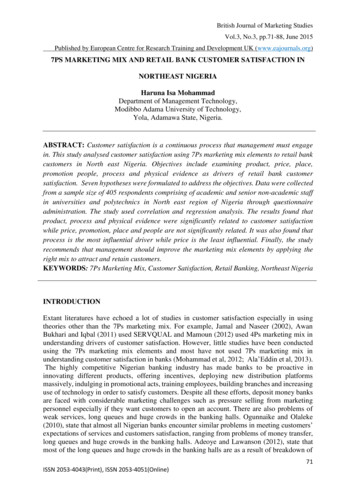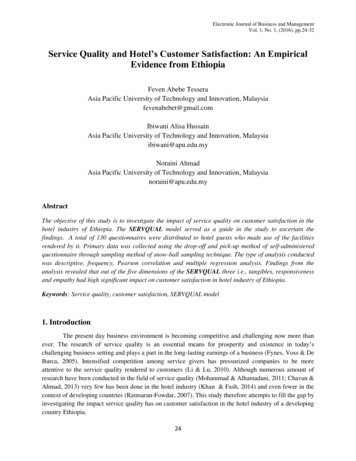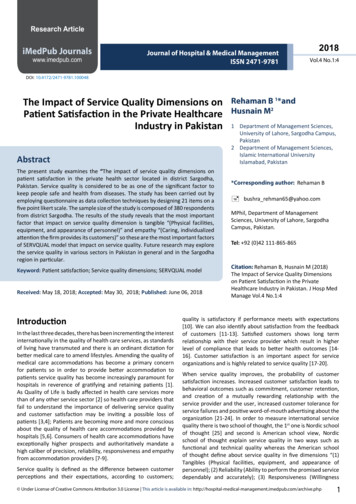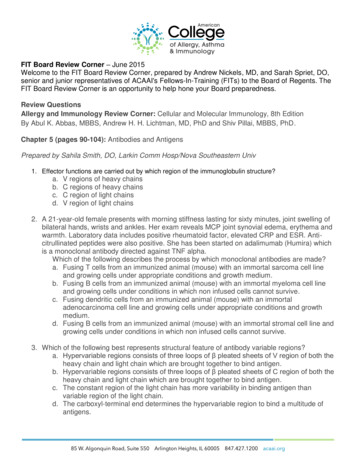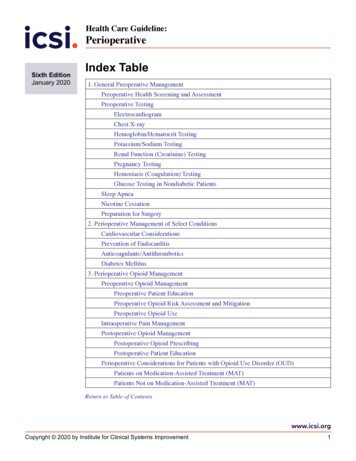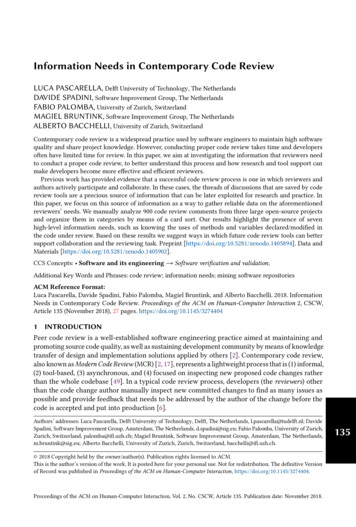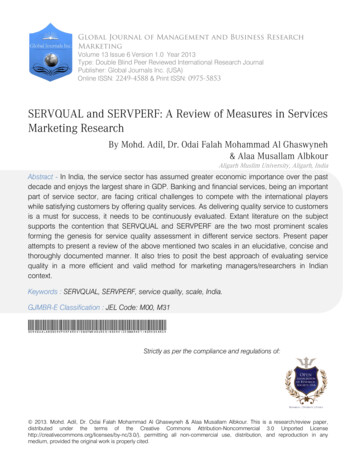
Transcription
Global Journal of Management and Business ResearchMarketingVolume 13 Issue 6 Version 1.0 Year 2013Type: Double Blind Peer Reviewed International Research JournalPublisher: Global Journals Inc. (USA)Online ISSN: 2249-4588 & Print ISSN: 0975-5853SERVQUAL and SERVPERF: A Review of Measures in ServicesMarketing ResearchBy Mohd. Adil, Dr. Odai Falah Mohammad Al Ghaswyneh& Alaa Musallam AlbkourAligarh Muslim University, Aligarh, IndiaAbstract - In India, the service sector has assumed greater economic importance over the pastdecade and enjoys the largest share in GDP. Banking and financial services, being an importantpart of service sector, are facing critical challenges to compete with the international playerswhile satisfying customers by offering quality services. As delivering quality service to customersis a must for success, it needs to be continuously evaluated. Extant literature on the subjectsupports the contention that SERVQUAL and SERVPERF are the two most prominent scalesforming the genesis for service quality assessment in different service sectors. Present paperattempts to present a review of the above mentioned two scales in an elucidative, concise andthoroughly documented manner. It also tries to posit the best approach of evaluating servicequality in a more efficient and valid method for marketing managers/researchers in Indiancontext.Keywords : SERVQUAL, SERVPERF, service quality, scale, India.GJMBR-E Classification : JEL Code: M00, arketingResearchStrictly as per the compliance and regulations of: 2013. Mohd. Adil, Dr. Odai Falah Mohammad Al Ghaswyneh & Alaa Musallam Albkour. This is a research/review paper,distributed under the terms of the Creative Commons Attribution-Noncommercial 3.0 Unported .0/), permitting all non-commercial use, distribution, and reproduction in anymedium, provided the original work is properly cited.
SERVQUAL and SERVPERF: A Review ofMeasures in Services Marketing Researcheconomic importance over the past decade and enjoys thelargest share in GDP. Banking and financial services, being animportant part of service sector, are facing critical challengesto compete with the international players while satisfyingcustomers by offering quality services. As delivering qualityservice to customers is a must for success, it needs to becontinuously evaluated. Extant literature on the subjectsupports the contention that SERVQUAL and SERVPERF arethe two most prominent scales forming the genesis for servicequality assessment in different service sectors. Present paperattempts to present a review of the above mentioned twoscales in an elucidative, concise and thoroughly documentedmanner. It also tries to posit the best approach of evaluatingservice quality in a more efficient and valid method formarketing managers/researchers in Indian context. Literatureshows that in Indian context, SERVPERF has outperformedSERVQUAL as it not only cut down the number of variables butalso reduced the work load of customer survey and helped ingenerating unbiased responses. Thus, from a pragmaticviewpoint, it is expected that the paper will serve as a useful ofsource information for researchers interested in selecting themost efficient service quality scale for assessing servicequality in a developing economy like India as also solvingcomplex issues related to service quality and other behavioural outcomes such as customer satisfaction, loyalty,recommendation, trust, word-of-mouth etc. in their futureresearches.Keywords : SERVQUAL, SERVPERF, service quality,scale, India.OI.Introductionwing to liberalization and globalization measuresinitiated since 1991, the banking industry in Indiahas undergone a radical change. This measure,along with the rapid growth in the Indian economyfollowed by strong contribution from government, privateand foreign banks transformed the banking sector inIndia. Further, deregulation, increasing market size,increased competition, technological blend and attitudinal transformation lead bankers to be more sensitivetowards customers’ needs and their ultimate satisfaction.Author α : Department of Business Administration Aligarh MuslimUniversity, Aligarh, India. E-mail : adilcms07@gmail.comAuthor σ : Department of Business Administration, Northern BordersUniversity-Arar, Saudi Arabia.E-mail : odai ghasawneh82@yahoo.comAuthor ρ : Research Scholar, Department of Commerce AligarhMuslim University, Aligarh, India. E-mail : alaa albkour@hotmail.comAs the generation of income for banks revolvesaround the customer; rendering quality service, satisfaction and keeping them intact with the serviceprovider in a longer run, is a key for subsistence andsuccess. Numerous organizations have started embarking into multifaceted approaches to improve thequality of their services as they begin to grasp theverities behind what manufacturing sector learned in thepast few decades that- ‘quality does not improve unlessit is measured’. Therefore, the topic of service qualityhas increasingly been recognized as one of the keystrategic values of organizations in both the manufacturing and service sectors alike (Berry, Zeithaml andParasuraman 1985; Bitner, Booms and Tetreault, 1990;LeBlanc and Nguyen, 1988).a) Indian Banking Industry and Financial ServicesDuring the last decade the commercial-banks inIndia underwent through significant qualitative andquantitative changes and manifold growth. On onehand, bank had to shoulder the social responsibility totake a leading role in the balanced socio-economicdevelopment of India, while on the other hand, it wasasked to be concerned about level of profitability. Thedynamic process of development and diversificationcoupled with structural, financial and technologicalchanges have led to an ever growing competition, notonly among banks but also from non-banking institutions, it is high time that banks should create newfinancial services in order to improve banker-customerrelationship, to anticipate, identify, reciprocate andsatisfy their needs efficiently, effectively and profitably.The crucial role that the banking system playedin India to foster institutionalised savings and channelfunds in desired directions was recognised in the FirstFive-Year Plan, which emphasised that banking systemhad to be fitted into the scheme of development tomake the process of saving and their utilisation 'sociallypurposive'. After independence, the growth of bankingindustry has been phenomenal and has no parallelanywhere in the world. The spectrum of services offeredby banks is the widest in this country, considering that,elsewhere in the world; specialisation is more of theorder. The range of services offered by a commercialbank in India varies from advances to commercial andindustrial sector to advances to priority sector, i.e. toidentify borrowers and lend money at a subsidised rateto the economically weaker sections. Therefore, a 2013 Global Journals Inc. (US)65Global Journal of Management and Business Research ( E ) Volume XIII Issue VI Version IAbstract - In India, the service sector has assumed greaterYear 2013Mohd. Adil α, Dr. Odai Falah Mohammad Al Ghaswyneh σ & Alaa Musallam Albkour ρ
Year 2013SERVQUAL and SERVPERF: A Review of Measures in Services Marketing ResearchGlobal Journal of Management and Business Research ( E ) Volume XIII Issue VI Version I66commercial bank has to perform mass banking and atthe same time class banking for overall development ofthe country.Banking, being a customer-oriented servicesindustry, the customer is the centre of attention andcustomer service has to be the distinguishing factor. Thechallenge for banks is to lower costs, increase efficiency, while improving the quality of their service, andincrease customer satisfaction. Attention has nowturned to improving the quality of service encounter,when customers enter the bank and come into face-toface contact with bank staff (Chakravarty, 1996).b) Service QualityService quality is increasingly recognized asbeing of key strategic value by organizations. The costsand major benefits to be derived from successfulservice quality are highlighted by several authors(Crosby, 1991; Reichfeld and Sasser, 1990; Edvardssonand Gustavsson, 1991; Adil, 2012; Adil, 2013a, Adil,2013b) may be summarized as relating to: Satisfied and retained customers and employees; Opportunities for cross-selling; The attraction of new customers; Development of customer relationships; Increased sales and market shares; Enhanced corporate image; Reduced costs and increased profit margins andbusiness performance.Service quality has been variously defined asfocusing on meeting needs and requirements, and howwell the service delivered matches customers’ expectations. Perceived service quality is a global consumerjudgement or attitude, relating to service and resultsfrom comparisons by consumers of expectations ofservice with their perceptions of actual service performance (see, for example, Berry, Zeithaml and Parasuraman 1985, Grönroos, 1984). Major researchcontributions to defining service quality and establishingits determinants have emanated from North America(Berry, Zeithaml and Parasuraman 1985; Bitner, Boomsand Tetreault, 1990; LeBlanc and Nguyen, 1988;Parasuraman, Zeithaml and Berry 1985, 1988; Zeithaml,Berry and Parasuraman,, 1988); from Scandinavia(Edvardsson, Gustavsson and Riddle 1989; Grönroos,1984, 1988, 1990); and from the UK (Johnston,Silvestro, Fitzgerald and Voss 1990; Silvestro andJohnston, 1990). A number of these contributions havebeen reviewed by Lewis (1989a).c) Objectives The aim of the paper is to identify the mostprominent and frequently used scales for measuringthe service quality, specifically with regard tobanking sector. 2013 Global Journals Inc. (US) Based upon the extant literature, an attempt hasbeen made by the researchers to draw a line ofcomparison between both the scales related to theefficacy, robustness and parsimoniousness of thescales in measuring the quality of service both inIndia as well as in other countries. The paper also aims at highlighting the conceptualframework of SERVQUAL and SERVPERF scalesalong with the steps of their development.II.Literature ReviewThe significance of quality service in commercial retail banking is well documented in the servicequality literature (Buttle, 1996) and financial servicesinherently being intangible, difficult to evaluate and relyheavily on experience and credence qualities ofcustomers (Zeithaml, 1981; Zeithaml, Parasuraman andBerry, 1985). Previous researchers have proven itseffect/linkages on/with satisfaction and retention ofcustomer, positive word-of-mouth (Lewis, 1991; Rustand Zahorik, 1993, Newman, 2001; Caruana, 2002;Wang Lo and Hui., 2003, Yavas, Benkenstein andStudhldreier, 2004; Adil, 2012; Adil, 2013a), complaints,recommendation and switch overs (Yavas, Benkensteinand Studhldreier, 2004), loyalty (Anderson and Sullivan,1993; Bloemer, de Ruyter, and Peeters , 1998; Oliver,1999; Jones and Farquhar, 2003; Adil & Ansari, 2012;Adil & Khan, 2012) and profitability (Duncan and Elliott,2004; Lee and Hwan, 2005). Thus, there has been muchinterest in hypothesizing the relationship betweenservice quality and other consumer behavioural outcomes, for which a researcher is supposed to assessservice quality. Extant studies suggest that there are twobroad dimensions to it i.e. outcome aspects andrelational aspects (Parasuraman, Zeithaml and Berry,1991; Morgan and Piercy, 1992; Levesque and McDougall; 1996).Outcome or operational, is the tangible component consisting of dimensions like timeliness, accuracy, convenience which is centrally related to bank’soperations and delivery systems. While this componenthas been largely studied by the researchers, it primarilyimpacts current customers with whom the bank alreadyhas an ongoing customer relationship; that is, customers who have actually observed the quality of theseservices.Relational component is intangible and may bedescribed simply as customer treatment. Service qualityresearchers like Le Blanc and Nguyen (1988), Parasuraman, Zeithaml and Berry (1988), Cronin and Taylor(1992), Teas (1993), Avkiran, (1994), Angur, Nataraajanand Jaheera (1999), Bahia and Nantel (2000) andWang, Lo and Hui, (2003) argued that with technicalservices becoming more standardized, the relationalaspect becomes even more important. This element ismore subjective and essentially is based on how the
a) SERVQUALService quality is known to be an importantfactor in banking, and SERVQUAL provides a techniquefor assessing and managing service quality (Buttle,1996). The concept was conceptualised and proposedby Parasuraman, Zeithaml and Berry (1985) and thenfurther developed for the next eight years by the sameresearchers. Many other researchers have used theSERVQUAL dimensions as the basis for their research,and consequently SERVQUAL “has undoubtedly had amajor impact on the business and academic communities” (Buttle, 1996), and has been said to be “insightfuland [to remain] a practical framework to use in servicequality management” (Christopher, Payne andBallantyne, 2002).East, 1997 argue that SERVQUAL measuresservice quality through customers’ expectations i.e. whatfirms should provide in the industry being studied andtheir perceptions viz. how a given service providerperforms against these criteria). Numerous researchhad been carried out in the banking industry usingSERVQUAL model. Using structural equations model,Wang, Lo and Hui (2003) evaluated the antecedents ofservice quality and product quality, and their influenceson bank reputation in the banking industry of Chinawhere link amongst service quality and product qualityand bank reputation was observed. Angur, Nataraajanand Jaheera (1999) determined service quality inbanking industry in India where they found that theSERVQUAL instrument was four dimensional structureand more helpful in addressing service deficiencies.Similarly, Sureshchandar, Rajendran and Anantharaman(2003) examined service quality in public, private andforeign banks in India. Yavas, Bilgin and Shemwel(1997) investigated the relationship between servicequality, customer satisfaction, complaint behavior andcommitment in the banking industry of Turkey and foundthat customer contact personnel played a vital role in thedelivery of high quality service. In addition to thebanking sector, SERVQUAL has been applied to othersectors also, in different countries such as highereducation institutions, airport services, tourism sectorservices, accounting firms, medical services etc. (Buttle,1996; Fick and Ritchie, 1991; Lam, Wong and Yeung1997; Lim and Tang, 2000; Oldfield and Baron, 2000).i. SERVQUAL InstrumentSERVQUAL comprises 22 items (Likert-type)with five dimensions namely- tangibles, reliability, responsiveness, assurance and empathy. Each item inSERVQUAL instrument is of two types. One to measureexpectations about firms in general within an industryand the other measures perceptions regarding theparticular company whose service is being assessed.The quality gap (Q) is calculated by subtractingthe expectation (E) from the perception (P) value i.e. P-E Q. Summation of all the Q values provides an overallquality rating which is an indicator of relative importanceof the service quality dimensions that influencecustomers’ overall quality perceptions. Parasuraman,Zeithaml and Berry (1988) suggested that SERVQUALmay be used to: track service quality trends over time; compare branches within a bank or building society; compare an organization with its competitors; and categorize customers into perceived quality segments based on their individual SERVQUAL scores.The original SERVQUAL instrument, proposedby Parasuraman, Zeithaml and Berry (1985), identifiedten components of service quality. Later, in a furtherstudy, those ten components were merged into fivedissimilar dimensions viz. reliability (5 items) which is theability to perform the service in an accurate and independable manner; tangibles (4 items) which refers tothe appearance of physical factors such as equipment,facilities and personnel; empathy (5 items) whichinvolves providing individual attention and care tocustomers; responsiveness (4 items) is the willingnessto provide help and prompt service to customers; andfinally assurance (4 items) refers to the knowledge andcourtesy of employees and their ability to convey trustand confidence.Table 1 : Dimensions of Service QualitySource : Adopted from Soteriou and Zenios (1997). 2013 Global Journals Inc. (US)67Global Journal of Management and Business Research ( E ) Volume XIII Issue VI Version Icustomer is made to feel when interacting with theinstitution and staff. This component affects both currentand new or prospective customers (i.e. those who comein to see someone in the bank about a banking service).Models have been developed to assess thedeterminants of service quality. The works of Parasuraman, Zeithaml and Berry (1985, 1988, 1991, and1994) led to the development of a service quality model-SERVQUAL, which compares expectations and perceptions of customers regarding a particular service. SinceParasuraman, Zeithaml and Berry (1988) introduced theSERVQUAL instrument; many researchers have used,extended and developed this 22-item scale to studyservice quality in different sectors of the servicesindustry (Avkiran, 1994; Babakus and Boller, 1992;Buttle, 1996; Cronin and Taylor, 1994; Fick and Ritchie,1991; Newman, 2001; Smith, 1995).Cronin and Taylor modified the gap-basedSERVQUAL scale into SERVPERF, a performance-onlyindex. Their study was later replicated by Brady, Croninand Brand.Year 2013SERVQUAL and SERVPERF: A Review of Measures in Services Marketing Research
SERVQUAL and SERVPERF: A Review of Measures in Services Marketing ResearchYear 2013SERVQUAL service quality model consists of several quality gaps (Q) which are as follows:Global Journal of Management and Business Research ( E ) Volume XIII Issue VI Version I68Source : Parasuraman, Zeithaml and Berry (1985).Figure 1 : Gap Model of Service QualityGap 1: The manager perceives the customers’ expectations differently from the customers,Gap 2: The service quality specifications do not agreewith management perceptions of qualityexpectations,Gap 3: Difference between quality specifications of thepromised service and the final service delivered,Gap 4: Promises made by market communicationactivities are not met by the delivered service,Gap 5: Difference between the expectations of whatfirms should provide in the industry and theirperceptions of how a given service providerperforms,Gap 6: Difference between the expectations of whatfirms should provide in the industry and theiremployee’s perceptions of consumer expectation, andGap 7: Difference between the employee’s perceptionsof consumer expectation and Management’sperceptions of consumer expectation.iii. SERVQUAL Applications and CriticismsAlthough many studies have used theSERVQUAL model as a framework in measuring service 2013 Global Journals Inc. (US)quality, there has also been theoretical and operationalcriticisms directed towards this model exist in theliterature of services marketing. These criticisms havemainly revolved around right from its dimensionalstructure to the interpretation and implementation of theinstrument (Buttle, 1996; Babakus and Boller, 1992; LamWong and Yeung, 1997; Smith, 1995; Newman, 2001).A number of researchers have reported differentdimensions for expectations, perceptions and gapscores. Thus, the universality of SERVQUAL’s fivedimensions has been questioned (Buttle, 1996; Carman,1990; Cronin and Taylor, 1994). Shortcomingsconcerning convergent and discriminant validity havealso been noted (Buttle, 1996). Nevertheless, despitethe criticism, SERVQUAL has been widely used invarious contexts throughout other studies. TheSERVQUAL instrument has been widely used because it“provides a basic skeleton. which can be adapted orsupplemented to fit the characteristics or specificresearch needs of a particular organization. . .”(Parasuraman, Zeithaml and Berry, 1988).
SERVQUAL and SERVPERF: A Review of Measures in Services Marketing ResearchCronin and Taylor (1992) in their empirical workcontroverted the framework of Parasuraman, Zeithamland Berry (1985, 1988) with respect to conceptualizationand measurement of service quality, and propounded aperformance-based measure of service quality called‘SERVPERF’ illustrating that service quality is a form ofconsumer attitude. They argued that SERVPERF was anenhanced means of measuring the service qualityconstruct. Their study was later replicated and findingssuggest that little if any theoretical or empirical evidencesupports the relevance of the E-P quality gap as thebasis for measuring service quality.Levelling maximum criticism against SERVQUAL scale, Cronin and Taylor (1992) providedempirical evidences across four industries viz. fast food,pest control, dry cleaning and banking to support thesuperiority of their ‘performance only’ scale overSERVQUAL scale retaining the same items as had beenproposed by the Parasuraman, Zeithaml and Berry(1988). In equation form, SERVPERF service quality canbe expressed as:Year 2013b) SERVPERFc) Studies SearchSource : Martinez and Martinez (2010).Figure 2 : Performance Only Model (SERVPERF)The following procedure was used to obtain anample collection of studies reporting the use of bothSERVQUAL and SERVPERF scales. First, an electronicsearch of the following databases was conducted:Direct Science, Inderscience, Emerald, ProQuest (ABI/INFORM Global and dissertation abstracts). Secondly, amanual examination of the articles identified from thecomputer-based searches was carried out. Thirdly,manual searches of leading marketing and servicesjournals were conducted. The search process yieldedthe following studies using either the original scale in itstotality or a modified version of the same (see Table 2and Table 3). 2013 Global Journals Inc. (US)Global Journal of Management and Business Research ( E ) Volume XIII Issue VI Version I69
SERVQUAL and SERVPERF: A Review of Measures in Services Marketing ResearchYear 2013Table 2 : International StudiesGlobal Journal of Management and Business Research ( E ) Volume XIII Issue VI Version I70Note: QUAL-Original SERVQUAL; PERF-Original SERVPERF; MQUAL-Modified SERVQUAL;MPERF-Modified SERVPERF.Adapted from: Carrillat, Jaramillo and Mulki (2007).III.Conclusions & DiscussionOverall, a number of measures have beenproposed in the past to determine customer expectations, customer perceptions and overall satisfactionsin service industries but prominent among them areSERVQUAL and SERVPERF. Although, a number ofmeasurement problems have been highlighted byresearchers (e.g. Babakus and Boller, 1991; Carmen,1990; Lewis and Mitchell, 1990; Lewis, 1993), related toperformance minus customer expectation (P-E) gapmodel of SERVQUAL. Cronin & Taylor’s (1992) SERVPERF scale has been empirically tested and proven to 2013 Global Journals Inc. (US)be a better measure of service quality (Cronin andTaylor, 1992; Brown, Churchill and Peter, 1993) andperform better in assessing service quality in bankingindustry in emerging countries such as India (Jain &Gupta, 2004; Adil, 2012; Adil & Ansari, 2012; Adil,2013a; Adil, 2013b). In fact, the marketing literatureappears to offer considerable support for the superiorityof simple performance-based measures of servicequality (cf. Bolton and Drew 1991a,b; Churchill andSurprenant 1982; Mazis, Ahtola, and Klippel 1975;Woodruff, Cadotte, and Jenkins 1983).
SERVQUAL and SERVPERF: A Review of Measures in Services Marketing ResearchYear 2013Table 3 : National StudiesSource : Prepared by the researchers.Note: QUAL- Original SERVQUAL; PERF- Original SERVPERF; MQUAL- ModifiedSERVQUAL; MPERF- Modified SERVPERF.Original researchers of SERVPERF argued thatowing to the limitations of operationalization, conceptualization, measurement and applications of SERVQUAL’s scale, the performance-based measure wasan enhanced means of measuring the service qualityconstruct, triggering an interesting controversy in servicequality research. However, later Parasuraman, Zeithamland Berry (1994a) responded to the concerns of Croninand Taylor (1992) and Teas (1993) by empiricallyproving that the validity and alleged severity of many ofthose concerns raised by them were questionable, andin fact elaborated that though their approach forconceptualizing service quality could be revised,relinquishing it altogether in preference of the alternateapproaches as proclaimed by the critics did not seemjustified. In another empirical work, Parasuraman,Zeithaml and Berry (1994b) refined SERVQUAL’sstructure to embody not only the discordance betweenperceived service and desired service, but also thediscrepancy between perceived service and adequateservice.The complexity of service quality evaluations isevident in the many failed attempts to replicate thedimensional structure of service quality perceptions. Thewidely applied SERVQUAL scale (Parasuraman, Zeithaml and Berry 1985, 1988), for example, has beencriticized, as its five dimensions, namely, reliability,empathy, tangibles, responsiveness, and assurance,were difficult to replicate across diverse service contexts(Buttle 1996). Researchers in the past had identified arange of factors that includes 3 factors in an automotiveservicing context (Bouman and van der Wiele 1992), 4factors in the retail clothing sector (Gagliano andHathcote 1994), and 3 factors in the context of MBAstudents’ service quality perceptions (McDougall andLevesque 1994), uni-dimensional (Brown, Churchill, andPeter, 1993) while mixed results in the context of healthcare services (Wisniewski and Wisniewski, 2005; Rohiniand Mahadevappa, 2006).Role of expectations and its inclusion in theSERVQUAL measuring instrument is a cause of majorconcern. To a certain extent, in SERVQUAL there is anoverlap between the technical and functional dimensions. Furthermore, the use of a perception scale isjustified by the dynamic character of the Indian client’sexpectations and by the greater effort required by therespondents to complete two questionnaires, one priorusing the services (i.e. expectations) and another post 2013 Global Journals Inc. (US)Global Journal of Management and Business Research ( E ) Volume XIII Issue VI Version I71
SERVQUAL and SERVPERF: A Review of Measures in Services Marketing Researchexperiencing (i.e. perceptions). That would markedlyreduce the number of respondents willing to respondtheir genuine feedback in the study. The SERVPERFscale is found to be superior not only as the scale isefficient in capturing the true customer’s perceivedservice quality as also more effective in reducing thenumber of items to be measured by half viz. 22 items incontrast to SERVQUAL’s 44 items (Hartline and Ferrell,1996; Babakus and Boller, 1992; Bolton and Drew,1991).Year 2013References Références ReferenciasGlobal Journal of Management and Business Research ( E ) Volume XIII Issue VI Version I721. Adil, M. (2011), “Assessing service quality at publicsector bank: A comparative study of urban and ruralcustomers”, International Journal for Business,Strategy & Management, Vol. 1, No. 1, pp. 1-9.2. Adil, M. (2012), “Customer tradeoffs betweenperceived service quality and satisfaction: A SEMapproach towards Indian rural retail banks”, InRahela Farooqi and Saiyed Wajid Ali (Ed.) EmergingParadigms in Marketing, Wisdom Publications: NewDelhi. pp. 3-16.3. Adil, M. and Ansari, S.A. (2012), “Service quality andcustomer loyalty at Indian rural banks: An empiricaltest of an integrative model”, Proceedings of TheNational Conference on Contemporary Issues inBusiness, Management & Finance, University ofKashmir, India.4. Adil, M. (2013). "The relationship between servicequality and customer satisfaction in India’s ruralbanking sector: An item analysis and factor-specificapproach”, The Lahore Journal of Business, Vol. 1,No. 2, pp. 43-63.5. Adil, M. (2013a). “Efficacy of SERVPERF inmeasuring perceived service quality at rural retailbanks: Empirical evidences from India”, International Journal of Business Insights and Transformation, Vol. 6, No. 1, pp. 52-63.6. Adil, M. (2013b). “Modelling effect of perceivedservice quality dimensions on customer satisfactionin Indian bank settings”, International Journal ofServices and Operations Management, Vol. 15, No.3, pp. 358-373.7. Anderson, Eugene W. and Sullivan, Mary W. (1993),“The antecedents and consequences of customersatisfaction for firms”, Marketing Science, Vol. 12,No.2, pp. 125-43.8. Angur, Madhukar G., Nataraajan, Rajan and Jahera,John S. Jr. (1999), “Service quality in the bankingindustry: An assessment in a developing economy”,International Journal of Bank Marketing, Vol. 13,No.3, pp. 116-23.9. Avkiran, Necmi Kemal (1994), “Developing aninstrument to measure customer service quality inbranch banking”, International Journal of BankMarketing, Vol. 12, No. 6, pp. 10-18. 2013 Global Journals Inc. (US)10. Babakus, Emin and Boller, Gregory W. (1992), “Anempirical assessment of the SERVQUAL scale”,Journal of Business Research, Vol. 24, No.2, pp.253-68.11. Bahia, K. and Nantel, J. (2000), “A reliable and validmeasurement scale for the perceived service qualityof banks”, International Journal of Bank Marketing,Vol. 18, No.2, pp. 84-91.12. Berry, Leonard L., Zeithaml, Valarie A. andParasuraman, A. (1985), “Quality counts in servicestoo”, Business Horizons, Vol. 28, No.3, pp. 44-52.13. Bloemer, J., de Ruyter, K. and Peeters, P. (1998),“Investigating drivers of bank loyalty: The complexrelationship between image, service quality andsatisfaction”, International Journal of Bank Marketing, Vol. 16, No.6 & 7, pp. 276-8614. Bitner, Mary J., Booms, B.H. and Tetreault, M.S.(1990), “The service encounter: diagnosing favourable and unfavourable
Marketing . Volume 13 Issue 6 Version 1.0 Year 2013 . Type: Double Blind Peer Reviewed International Research Journal Publisher: Global Journals Inc. (USA) Online ISSN: 2249-4588 & Print ISSN: 0975-5853. SERVQUAL and SERVPERF: A Review of Measures in Services Marketing Research By Mohd. Adil, Dr. Odai Falah Mohammad Al Ghaswyneh



